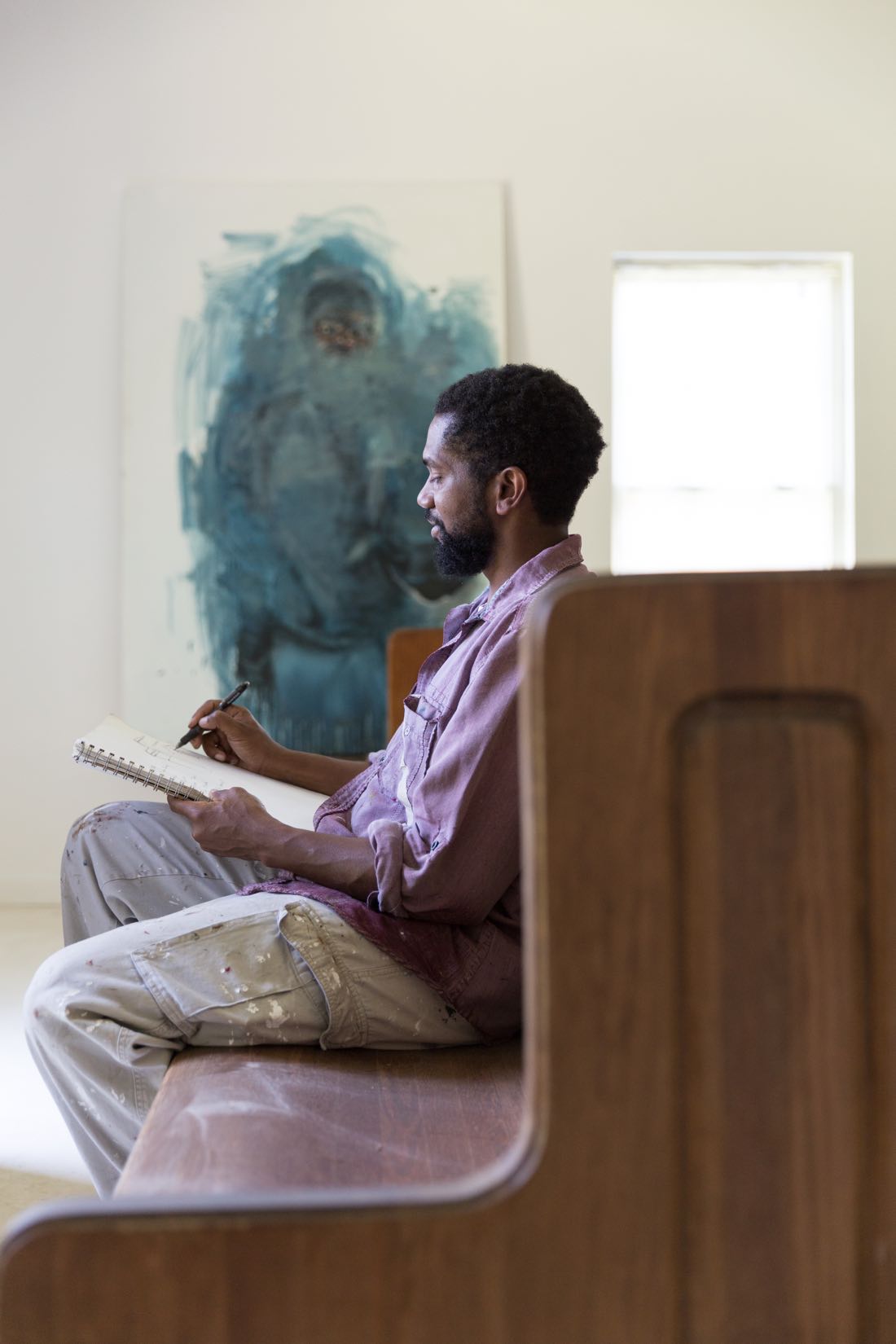Painting Letitia
Painter Sedrick Huckaby treats everyday people like celebrities
By Marc Chalufour | Photos by Justin Clemons
In his earliest works, painter Sedrick Huckaby found inspiration in a classic childhood genre: comic book superheroes. Now an established artist with works in the permanent collections of Boston’s Museum of Fine Arts and New York’s Whitney Museum of American Art, Huckaby (BUTI’95, CFA’97) finds inspiration in a different sort of hero: the members of his family and his African American community. “Ordinary people matter,” Huckaby told art+seek, and much of his work applies this statement on a monumental scale.

When revisiting his family portrait series, Huckaby started one—the portrait of his wife Letitia—from scratch.
For his first New York City show, The 99%, Huckaby covered a wall with 101 black-and-white portraits of people from his neighborhood, making each sitter look “casually but distinctly regal,” according to the New York Times. By contrast, the canvas for his 80-foot-wide A Love Supreme is filled by a single painting of brightly colored quilts, a craft he associates with his family. “Huckaby has managed to stay true to himself, his family, and to a rigorous practice of lovingly recording the world he knows with great sincerity,” painter Bruce Herman (’77,’79) wrote for Image. “[He reveals] a depth of religious wisdom seldom found in contemporary art culture, laden as it often is with fashionable irony.”
After graduating from BU, Huckaby earned an MFA at Yale, then traveled throughout Europe for two years, studying the continent’s old masters. He eventually returned to his hometown, Fort Worth, Tex., where he has established himself as a master in his own right. His critically acclaimed works are highly sought after by museums and collectors, with some selling for tens of thousands of dollars. He’s even mentored another famous Texas painter, former president George W. Bush, whom he encouraged to paint the people who inspired him. Bush embraced the idea, creating Portraits of Courage, a series depicting US military veterans.
Huckaby hasn’t let success stunt his growth as an artist, though; he continues to experiment and to refine his work. His 2016 exhibit, Three Forbidden F Words: Faith, Family, and Fathers, at Valley House Gallery in Dallas, Tex., represented the first realization of an idea he had for a family portrait comprising massive individual paintings of himself, his wife, Letitia, and their children. The show also revealed a restless creative mind, as Huckaby immediately began imagining ways to improve upon the portraits. And in the case of one—a portrait of Letitia—he decided to start from scratch.
Back to the Drawing Board
Three Forbidden F Words included five paintings: Little B, Letitia, Sedrick, Halle Lujah, and Rising Sun. “When I decided to go large scale, that’s a definite decision,” he says. “I’m saying, ‘I want to make, in essence, a larger statement.’” At the start, he’d wanted to go even larger—16 feet in height for each portrait—but needing to get everything done in time for the exhibit meant scaling them back to 8 feet. The result filled a gallery wall from floor to ceiling.

Taking his interest in family a step further, Huckaby has converted his grandmother’s house into a studio and art installation where he works on current projects.
The faces of Huckaby’s family, rendered in his unique impasto style, stared out from the massive canvases. Rectangle and oval frames alternated across the wall. Subtle differences in attire hinted at the figures’ identities: the son wears a hooded sweatshirt, the wife covers her hair with a headdress. It’s the faces, though, that powered the exhibit. Though the features are defined by broad brushstrokes, they are delicate: the son’s youthful cheeks, the daughter’s lips. For the fifth painting, Little B, Huckaby used a strikingly different style: white and light purple streaks sweep across the silhouette of a small child, as though the observer is looking through fog. The figure represents the one member of the family for whom Huckaby had no sketches to work from, no reference material: a child lost in a miscarriage.
Some of Huckaby’s other creative decisions for the exhibit weren’t as final as the scale. He often refines his work over time, meaning that an exhibit is less of a culmination than a new beginning. “Many times I’ve done something and I’ve put it out prematurely only to think, ‘Man, if I could get that back I would do X, Y, and Z,” Huckaby says. As soon as he saw the portraits mounted side by side, he began reconsidering spacing, lighting, and other stylistic choices.

Huckaby references and draws inspiration from past projects that hang throughout the home.
So when the exhibit ended, Huckaby took the family back to his studio. He retouched each painting, adding detail, altering lighting. He also began planning a new exhibit, with the portraits clustered tightly, their edges overlapping, like a family huddled together for a group photo. “The bunch makes the paintings act more like people,” Huckaby says. “It’s more rhythmic and dynamic.”
Throughout the process, Huckaby used a variety of references he’d created over the years. “Each member of my family sat for oil pastels, then I used those to sketch from,” he says. He pulled out these color studies and sketches as needed, each iteration of the portrait helping him understand an aspect of the finished work. Color, spacing, shape—these are all details he experimented with before arriving at the finished portraits.
“People generally think of being able to render something lifelike as being a very hard thing to do,” Huckaby says. “But being loose and allowing the paint to have a looseness to it, while at the same time still having a sense of control—that’s harder.”
A Face Emerges
With the portrait of his wife, Huckaby saw enough details he wanted to change that he started over with a fresh canvas, creating The Family: Letitia (2018). He constructed Letitia’s oval canvas by attaching curved pieces to each side of a large rectangle. The seams where the pieces met would eventually show through the paint, creating a faint frame within the frame, tightly cropping Letitia’s face—and matching the other portraits in the family. Huckaby glued the canvas to a heavy wood panel. “That’s important,” he says, “because I stack up a whole lot of paint on there.” With that massive panel leaning against a studio wall, he began painting.

To paint the large-scale portraits in his Three Forbidden F Words series, Huckaby first drew each family member in oil pastels (below). He used these pieces to sketch from. Each iteration of the portrait helped him understand the finished work.

“I will start off with the paint very thin and sort of washy,” he says. Gradually, a faint monochromatic portrait emerges. It’s a guide for Huckaby’s next steps, which slowly bring the picture into sharper focus. “I will build up the image, add some color to it. And then I’ll start loading it up with paint.”
He mashed paint remnants he’d saved from past projects and Galkyd, a fast-drying compound, onto the canvas, building up Letitia’s forehead, nose, and lips. “I pile it on with palette knives and some big, thick gloves,” he says. “I mix it all together and push it and plow it into place.” In some spots, the paint was an inch and a half thick.
Then he picked up a brush again and began developing details and colors. “I’m working from life and I’m working with the colors that I see,” Huckaby says. “But I try to, at times, mimic the colors that I’m seeing using the most intense versions—so they’re a little bit of a souped-up version of what I’m seeing.” That meant choosing from upwards of two dozen colors in his palette, which bear names like cadmium orange, sap green, and burnt umber.
Inspiration and Interpretation
When he talks about his painting, Huckaby could just as easily be describing one of his artistic inspirations: jazz musician John Coltrane—whose album A Love Supreme Huckaby honored with his quilt painting. “He knew where he was in his music and he was constantly pushing toward a certain edge, pushing to go over and beyond a certain threshold,” Huckaby says. Whether working with a saxophone or a brush, there’s a process and structure to the art, but also plenty of space for inspiration and interpretation. It’s that fluidity that leads to stylistic shifts and breakthroughs.
As he re-created Letitia, Huckaby kept pushing an idea he’d been working on. “One of the things that has been entering into my paintings a little more, as I’ve gone along, the paint has gotten a lot more fluid. It starts to drip, it splashes,” he says. “Textures, marks, even something as simple as transparency to opacity, it all becomes language to me. The splashes give the painting another kind of feel to it, it helps it to speak in a slightly different voice.”
The face staring out from the oval canvas seems timeless, unanchored in any particular era—an effect captured in many of Huckaby’s portraits. Its features are smoother and more subtly realized than those of the earlier version of Letitia. Browns, reds, and oranges combine to define her face, from her delicate cheekbones to the slightly upturned corners of her mouth. The blue headdress and a matching top frame the face, whites and blues blending to give the fabrics texture. The tiniest spots of white give her eyes a spark echoed in the other members of The Family.

The Family: Letitia (2018)
The Family Redux
Huckaby’s second exhibit of The Family began in May 2018 at the Art Museum of South Texas in Corpus Christi. To complete the installation, Huckaby re-created the series in miniature. He wanted visitors to see the family in different ways as they moved through the exhibit. “Many times in life, people only see things from one perspective,” he says.
Huckaby’s final showing of The Family: Letitia (2018) came one year later, at the 2019 Dallas Art Fair, where the painting sold to a private collector. After more than three years, the members of Huckaby’s family portrait were each going their own way. “It’s like they’re characters in a story,” Huckaby says. “At the end of a story, everyone ends up doing different things.”
If there was anything about Letitia that Huckaby felt needed more work, he’s not saying now. “It’s about as done as it’s going to be,” he says with a laugh. “Anything else I would’ve done to it, I need to create another painting.”










